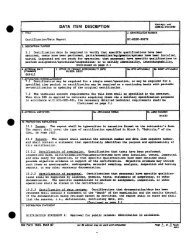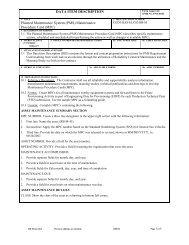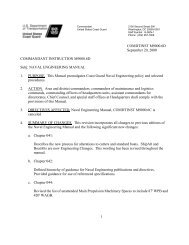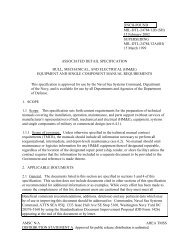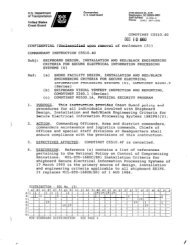NAVAIR INSTRUCTION 4120.11 From: Commander, Naval Air ...
NAVAIR INSTRUCTION 4120.11 From: Commander, Naval Air ...
NAVAIR INSTRUCTION 4120.11 From: Commander, Naval Air ...
- No tags were found...
You also want an ePaper? Increase the reach of your titles
YUMPU automatically turns print PDFs into web optimized ePapers that Google loves.
<strong>NAVAIR</strong>INST <strong>4120.11</strong><br />
GRAPHICS: Various levels of graphics display,<br />
interactivity, and navigation can be implemented<br />
through ETMs. Examples of these functionalities<br />
include<br />
• Point and click on a locator graphic for the<br />
purpose of “drilling down” to graphic details<br />
• Links to textual or tabular information<br />
• Highlighting specific connections in a circuit<br />
• System simulation expressed graphically<br />
• Full 3D models that can be rotated with parts<br />
removed<br />
The more complex graphical navigational techniques<br />
often come at a premium for both cost and system<br />
hardware/software requirements.<br />
LINKING: ETM basic linking functionality is defined<br />
as essentially link access or connections to the<br />
data within the ETM such as from the table of<br />
contents to the applicable ETM section. Additional<br />
linkage such as cross-references may require some<br />
additional effort to maintain. Linking to data items<br />
external to the ETM can also be acquired. These<br />
links may be to resources such as material handling<br />
information or for integration with other related<br />
information.<br />
NAVIGATION and TRACKING: ETMs exhibit a number of<br />
different navigation methods that enable linear and<br />
nonlinear access through the data. Features such as next<br />
and back, search, and the use of bookmarks are considered<br />
to be relatively fundamental and consistent with most<br />
web-based data presentation techniques. Higher complexity<br />
navigation techniques include dialog driven interaction,<br />
voice activated commands and various filtering<br />
techniques. Examples of filtering characteristics are<br />
model number, identification number (e.g. tail<br />
number/BUNO), modification performed, and user<br />
qualifications. Tracking provides the ability to allow<br />
recording and subsequent retrieval of ETM activity, as in<br />
an audit trail. Levels of audit trails include a history<br />
of the current ETM session (browser history for data<br />
traversed), logging all actions performed for maintenance<br />
7 Enclosure (2)





